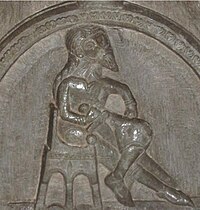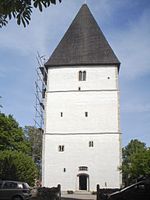Ingrid Ylva
Ingrid Ylva (Ingrid the wolf), and Ingrid Ylva Sunesdotter (* 1180, † 26. October 1252 ) (?), One was Swedish princess from the House of Sverker ( Swedish : Sverkerskaätten), a Swedish royal family. As the wife of Magnus Minnesköld von Bjälbo, she became the ancestor of the Swedish ruling dynasty of the Folkunger (Swedish: Folkungaätten or Bjälboätten), which produced a large number of high dignitaries.
origin
Ingrid Ylva Sunesdotter came from the House of Sverker , (Swedish: Sverkerskaätten) mounted on I. Sverker , king returned from Östergötland and then from all of Sweden (1130-1156), back. The House of Sverker was four generations in one - run with varying success - fight for the Swedish krona with the House of Eric , the on Erik IX. Jedvardsson “the saints”, King of Sweden (1156–1159), goes back.
Ingrid Ylva was a daughter of the Swedish prince Sune Sik (* c. 1154), who - if you follow the work of the Swedish reformer and historian Olaus Petri (* 1493, † 1552) was a younger son of Sverker I (1130-1156) . This ancestry can also be found in the European family tables. Ingrid's grandfather was therefore King Sverker I of Sweden, who was second married to Princess Ryksa (Rycheza) of Poland (* 1116, † after 1155), a daughter of Boleslaw III. "Krzywousty" (crooked mouth) , Duke of Poland (1102–1138) from the house of the Piasts , was married. Through his mother, the Princess Judith of Franconia (* 1054, † 1092/96), the youngest daughter of the Roman Emperor Heinrich III. (1084–1106) with Agnes von Poitou , Ingrid Ylva also descended from the Salian dynasty . Ingrid Ylva was therefore related to the first families in Europe. However, nothing is known about her mother and any siblings.
Life
In exile
Ingrid Ylva came from a Swedish royal family, but did not grow up at the royal court, as her family had lost the crown to the rival Eriks family after the murder of their grandfather King Sverker I of Sweden in 1156 . Although her uncle Charles VII Sverkersson was able to bring the crown back to the Sverker family in 1160, it was lost again to the Erik family in spring 1167 when Knut I Eriksson attacked Ingrid's uncle Charles VII on Visingö and killed him. Ingrid Ylva grew up under the rule of her family hostile Knut I. Eriksson, who ruled as King of Sweden from 1167 to 1196, as a member of the disempowered dynasty in banishment from the court in the province of Östergötland on her family's estates.
Part of the royal family again
Around 1195 she married Magnus Minnesköld von Bjälbo (Bjälboätten) and thus appeared more strongly in tradition. Through her marriage - which was probably arranged by her father - Ingrid Ylva became the sister-in-law of Birger Brosa , who as Jarl (Duke) in Sweden was the second man in the state from 1174 to 1202.
After the death of King Canute I Eriksson on April 8, 1196, the heir to the throne was Erik XI. (Sweden) still a small child. Ingrid Ylvas, her brother-in-law Jarl Birger Brosa, succeeded in getting her cousin, Sverker Sverkersson, to return from his Danish exile and - as the third of his house - as King Sverker II, to take over rule in the Kingdom of Sweden from 1196 to 1210 .
Raising children
Although her own family was now back in power, not much changed in Ingrid Ylva's life. There were appearances at her cousin's court, but her most important task was to bring up her own children and her husband's three children from his first marriage. She should have mastered this task quite successfully, since her eldest stepson Eskil Magnusson, († c. 1227), Lagman (law spokesman / district judge) in Västergötland , her stepson Karl Magnusson and her son Bengt Magnusson became bishops of Linköping one after the other , and her most gifted son, Birger Jarl (* c. 1210, † October 21, 1266 ), 1248 imperial administrator of the Kingdom of Sweden , founder of the city of Stockholm , and ancestor of the Folkung dynasty , which was from 1250 to 1387 as kings of Sweden, 1380 to Ruled as kings of Norway in 1387 and as kings of Denmark from 1376 to 1387 .
Struggle for power
The protector of the family - Jarl Birger Brosa - died in 1202. In the following year there was a dispute with the heir to the throne Erik Knutsson and his brothers, who went to Norway and from there acted against the rule of the Sverker. In 1205 the battle of Älgarås broke out , in which King Sverker II, Ingrid Ylva's cousin, was victorious, supported by her husband, Magnus Minnesköld. Three years later there was another fight: In the Battle of Lena (today Kungslena in Västergötland ) on January 31, 1208, King Sverker II was defeated by the army of his rival Erik Knutsson of the Erik family and had to flee to Denmark, whereupon Erik Knutsson fell when Erik X. proclaimed King of Sweden in 1208.
Ingrid Ylva's husband Magnus was believed to have died in this battle. However, it cannot be ruled out that Magnus Minnesköld survived, went into exile with Ingrid's cousin Sverker II in Denmark and only fell in the decisive battle of Gestilren on July 17, 1210 together with King Sverker II, thus making her a widow.
Widow in Bjälbo
Ingrid Ylva - widow and prominent representative of the defeated Sverker family - had no choice but to retire to her property in Bjälbo and from there to look after the family's extensive property in Östergötland. The town of Bjalbö and especially the church tower there became her favorite place to stay: she donated a bell to the parish church and had an apartment built in the tower from which she could not only hear mass but also retreat in times of danger .
Finally, the rival Swedish ruling houses were reconciled when Ingrid Ylva agreed that her son Birger Magnusson should marry Ingeborg Eriksdotter , a daughter of King Erik X. Knutsson of Sweden in 1235 , even though the latter was killed for the death of her husband and her royal cousin Sverker II. was responsible. After the death of the last king of the Erik family , Erik XI. Eriksson , in 1250 her grandson Waldemar Birgersson became King of Sweden and her son Birger Jarl became regent of Sweden.
Persistence in the legend
Various legends developed about the life of Ingrid Ylva, in which she is regularly described as a wise woman who mastered white magic and used it for her family, but also for the benefit of other people. White magic was a rare and highly respected art at the time, as it was often seen as the only way to protect crops from damage, protect people and animals from disease, secure fertility and experience the future.
Various legends have been passed down from Ylva. A legend claims that on the occasion of a siege by enemies, she climbed the church tower she loved, cut open a cushion of feathers and scattered the feathers across the country. To the astonishment of the besieging enemies, they are said to have turned into armed knights who drove them away. Their ability to predict the future was particularly appreciated. She is said to have predicted on her deathbed that her descendants would rule as long as her head was held up.
The traditional date of death is given as October 26, 1252, but this is not certain. In any case, she died in Bjälbo between 1250 and 1255. According to legend, her son, the regent Birger Jarl, had her buried in an upright position in the church tower of Bjälbo, which she valued so much during her lifetime, in order to secure the dynasty's existence according to the prophecy would have.
The tower of the parish church in Bjälbo, where she was allegedly buried, still stands today and keeps the memory of Ingrid Ylva alive centuries later.
Marriage and children
Ingrid Ylva married the Swedish aristocracy and district judge Magnus Minnesköld , also known as Magnus Minniskiöld, around 1195 . (* approx. 1175, † probably in the Battle of Lena on January 31, 1208 ). His family, which after their ancestral seat Bjälbo (today in the municipality of Mjölby in Östergötland ) was called the "Bjälbo family" (Swedish: Bjalboätten ), went down in history as the House of Folkung, a name that goes back to the first known progenitor this family Folke den Dicken , who lived around 1100. Children:
- Bengt Magnusson (Bjälboätten) († January 4, 1237), succeeded his brother Karl Magnusson as Bishop of Linköping (1220–1236)
- Birger Magnusson (Bjälboätten), called Birger Jarl (* approx. 1210, † October 21, 1266 ), 1248 imperial administrator of the Kingdom of Sweden, founder of the city of Stockholm ⚭ 1.) Ingeborg Eriksdotter, Princess of Sweden († June 17, 1245), daughter from King Erik X. Knutsson of Sweden (1208-1216) ⚭ 2.) 1261 Mechthild von Holstein (* 1220/25, † 1288 in Kiel ); Widow of King Abel of Denmark (1250–1252), daughter of Count Adolf IV. Von Schauenburg and Holstein .
- His son Waldemar I. Birgersson (* 1243 , † December 26, 1302 ) was the successor of his maternal uncle - Erik XI. Eriksson , called "the Lispelnde and Lahme" King of Sweden (1222–1250) - as the first of his house of Bjälboätten - better known as Folkunger - King of Sweden (1250–1275)
Individual evidence
- ^ Olaus Petri: En svensk krönika (A Swedish Chronicle)
- ↑ Detlev Schwennicke : European Family Tables , Verlag JA Stargardt, Marburg, 1980 New Series, Volume II, Plate 115.
- ↑ Detlev Schwennicke: European Family Tables , Verlag JA Stargardt, Marburg, 1980 New Series, Volume I, Tafe1 4
- ↑ Detlev Schwennike: Europäische Stammtafeln , Verlag JA Stargardt, Marburg, 1980 New Series, Volume III.1, Tafe1 162
- ↑ According to Detlev Schwennike: Europäische Stammtafeln, Verlag JA Stargardt, Marburg, 1980 New Series, Volume II, Plate 116
literature
- Jan Guillou : Häxornas försvarare. Ett historiskt report. Pirat, Stockholm 2002, ISBN 91-642-0037-X .
- Halvdan Koht: The Scandinavian Kingdoms until the End of the Thirteenth Century. In: HM Gwatkin et al. (Ed.): The Cambridge medieval History. Volume 6: Victory of the Papacy. Cambridge University Press, Cambridge et al. 1929, pp. 362-392.
- Christer Öhman: Helgon, bönder och krigare. Berättelser ur den svenska historien. Rabén Prisma, Stockholm 1994, ISBN 91-518-2667-4 .
- Runeberg.org .
See also
Web links
| personal data | |
|---|---|
| SURNAME | Ingrid Ylva |
| ALTERNATIVE NAMES | Ingrid Ylva Sunesdotter Sverkerskaätten |
| BRIEF DESCRIPTION | Swedish nobles |
| DATE OF BIRTH | around 1180 |
| DATE OF DEATH | October 26, 1252 |
| Place of death | Bjälbo |



